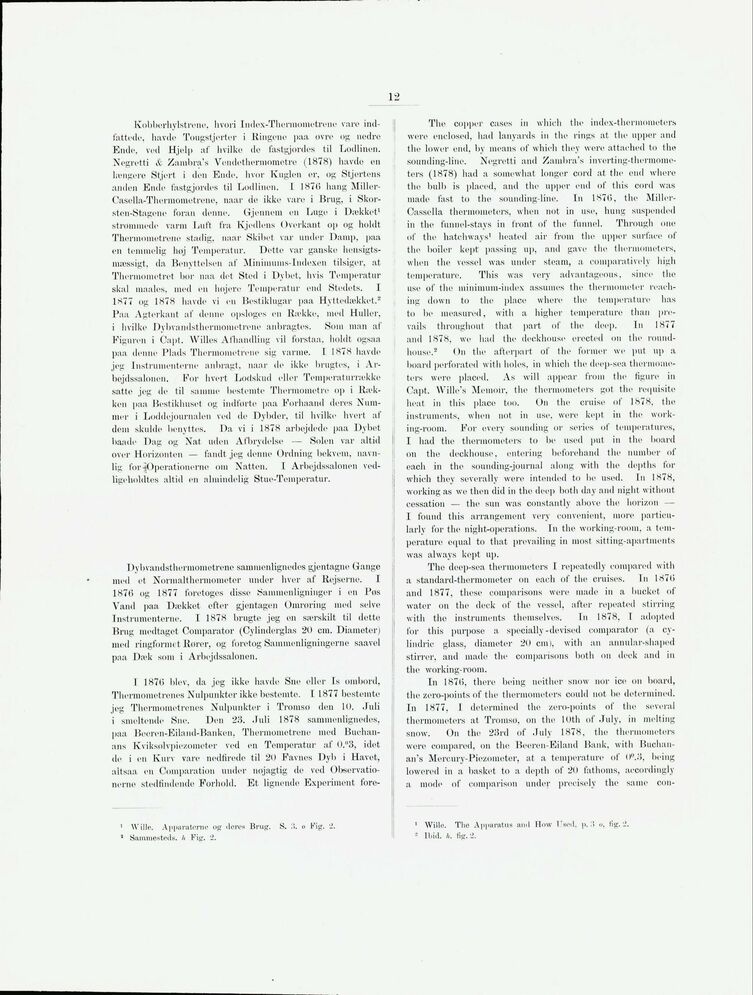
Full resolution (JPEG) - On this page / på denna sida - Sidor ...

<< prev. page << föreg. sida << >> nästa sida >> next page >>
Below is the raw OCR text
from the above scanned image.
Do you see an error? Proofread the page now!
Här nedan syns maskintolkade texten från faksimilbilden ovan.
Ser du något fel? Korrekturläs sidan nu!
This page has never been proofread. / Denna sida har aldrig korrekturlästs.
Siile
Kobborhylstrene, hvori Index-Therniometrene vare
indfattede, havde Tougstjerter i Ringene paa ovre og nedre
Ende. ved Hjelp af hvilke de fastgjordes til Lodlinen.
Negretti & Zanibra’s Vendetherniometre (1878) havde en
længere Stjert i den Ende. hvor Kuglen er, og Stjertens
anden Ende fastgjordes til Lodlinen. 1 1876 haug
Miller-Casella-Thermometrene, naar de ikke vare i Brug, i
Skorsten-Stagene foran denne. Gjennem en Luge i Dækket1
strømmede varm Luft fra Kjedlens Overkant op og holdt
Thermometrene stadig, naar Skibet var under Damp, paa
en temmelig høj Temperatur. Dette var ganske
hensigtsmæssigt, da Benyttelsen af Miniinuins-Indexen tilsiger, at
Thermometret bor naa det Sted i Dybet, hvis Temperatur
skal maales, med en højere Temperatur end Stedets. I
1877 og 1878 havde vi en Bestiklugar paa Hyttedækket.2
Paa Agterkant af denne opsloges en Række, med Huller,
i hvilke Dybvandsthermometrene anbragtes. Som man af
Figuren i Capt. Willes Afhandling vil forstaa, holdt ogsaa
paa denne Plads Thermometrene sig varme. I 1878 havde
jeg Instrumenterne anbragt, naar de ikke brugtes, i
Ar-bejdssalonen. For hvert Lodskud eller Temperaturrække
satte jeg de til samme bestemte Thermometre op i
Rækken paa Bestikhuset og indførte paa Forhaand deres
Nummer i Loddejournalen ved de Dybder, til hvilke hvert af
dem skulde benyttes. Da vi i 1878 arbejdede paa Dybet
baade Dag og Nat uden Afbrydelse — Solen var altid
over Horizonten — fandt jeg denne Ordning bekvem,
navnlig for ^Operationerne om Natten. I Arbejdssalonen
vedligeholdtes altid en almindelig Stue-Temperatur.
Dybvandsthermometrene sammenlignedes gjentagne Gange
med et Norm al thermometer under hver af Rejserne. I
1876 og 1877 foretoges disse Sammenligninger i en Pøs
Vand paa Dækket efter gjentagen Omrøring med selve
Instrumenterne. I 1878 brugte jeg en særskilt til dette
Brug medtaget Comparator (Cylinderglas 20 cm. Diameter)
med ringformet Rører, og foretog Sammenligningerne saavel
paa Dæk som i Arbejdssalonen.
I 1876 blev, da jeg ikke havde Sne eller Is ombord,
Thermometrets Nulpunkter ikke bestemte. I 1877 bestemte
jeg Thermometrenes Nulpunkter i Tromsø den 10. Juli
i smeltende Sne. Den 23. Juli 1878 sammenlignedes,
paa Beeren-Eila nd-Banken, Thermometrene med
Buchanans Kviksølvpiezoineter ved en Temperatur af 0.°3, idet
de i en Kurv vare nedfirede til 20 Favnes Dyb i Havet,
altsaa en Comparation under nojagtig de ved
Observationerne stedfindende Forhold. Et lignende Experiment fore-
1 Wille. Apparaterne og deres Brug. S. II. o Fig. 2.
’ Sammesteds, h Fig. 2.
The copper cases in which the index-thermömeters
were enclosed, had lanyards in the rings at the upper and
the lower end, by means of which they were attached to the
sounding-line. Negretti and Zanibra’s
inverting-thermome-ters (1878) had a somewhat longer cord at the end where
the bulb is placed, and the upper end of this cord was
made fast to the sounding-line. In 1876, the
Miller-Cassella thermometers, when not in use, hung suspended
in the funnel-stavs in front of the funnel. Through one
of the hatchways’ heated air from the upper surface of
the boiler kept passing up, and gave the thermometers,
when the vessel was under steam, a comparatively high
temperature. This was very advantageous, since the
use of the minimum-index assumes the thermometer
reaching down to the place where the temperature has
to be measured, with a higher temperature than
prevails throughout that part of the deep. In 1877
and 1878, we had the deckhouse erected on the
roundhouse.2 On the afterpart of the former we put up a
board perforated with holes, in which the deep-sea
thermometers were placed. As will appear from the figure in
Capt. Wille’s Memoir, the thermometers got the requisite
heat in this place too. On the cruise of 1878, the
instruments, when not in use, were kept in the
working-room. For every sounding or series of temperatures,
I had the thermometers to be used put in the board
on the deckhouse, entering beforehand the number of
each in the sounding-journal along with the depths for
which they severally were intended to be used. In 1878,
working as we then did in the deep both day and night without
cessation — the sun was constantly above the horizon —
I found this arrangement very convenient, more
particularly for the night-operations. In the working-room, a
temperature equal to that prevailing in most sitting-apartments
was always kept up.
The deep-sea thermometers I repeatedly compared with
a standard-thermometer on each of the cruises. In 1876
and 1877, these comparisons were made in a bucket of
water on the deck of the vessel, after repeated stirring
with the instruments themselves. In 1878, I adopted
for this purpose a specially-devised comparator (a
cy-lindric glass, diameter 20 cm), with an annular-shaped
stirrer, and made the comparisons both on deck and in
the working-room.
In 1876, there being neither snow nor ice on board,
the zero-points of the thermometers could not be determined.
In 1877, I determined the zero-points of the several
thermometers at Tromsø, on the 10th of July, in melting
snow. On the 23rd of July 1878, the thermometers
were compared, on the Beeren-Eiland Bank, with
Buchanan’s Mercury-Piezometer, at a temperature of 0°.3, being
lowered in a basket to a depth of 20 fathoms, accordingly
a mode of comparison under precisely the same con-
1 Wille. The Apparatus and How Used, p..’! o, fig. 2.
- Ibid. h. fig. 2.
<< prev. page << föreg. sida << >> nästa sida >> next page >>